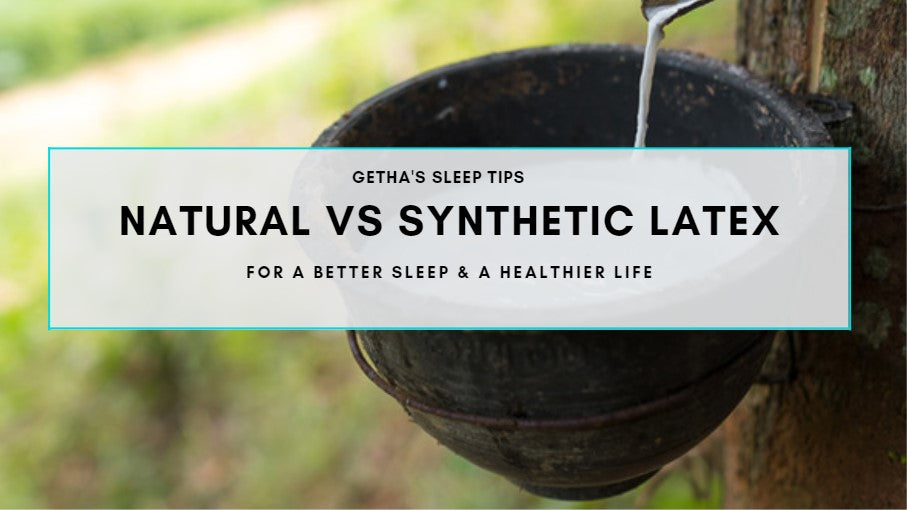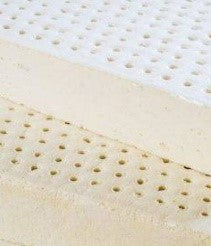
Latex has a great reputation for being one of the most luxurious and sought-after bedding materials available. Latex provides the perfect balance of comfort and support, contouring to your body like memory foam, while being resilient and feeling like a dream to sleep on. In lieu of its popularity, manufacturers have come out with different types of latex in the market. The word “latex” can be confusing because it describes both natural and synthetic latex. Synthetic latex is commonly found in mattresses as it is low cost for mattress makers, and can attract customers who are looking for a good deal.
Where do natural and synthetic latex come from?
100% natural latex is made of pure 100% natural sap from the rubber tree, whereas synthetic latex foam is derived from petrochemicals. Furthermore, consumers should also beware of the differences between natural latex and 100% natural latex as it is easy to misunderstand natural latex to be fully natural. Natural latex is commonly a combination blend made of both synthetic and natural, whereas 100% natural latex contains no fake latex chemicals.

|
100% Natural Latex
Made of pure 100% natural sap from the rubber tree with no fillers or blends. Kindly pay attention to products that claim to be “natural latex” which contains synthetic latex, and look for the word 100%. |
 |
Natural Latex
Natural latex is made of a blend of natural latex with fillers – typically synthetic latex. This is a cheaper and easier way to produce latex foam that contains real natural latex. |
 |
Synthetic latex
Commonly labelled as latex or 100% latex, it is not considered a natural product, as this foam material is completely man-made from petrochemicals to copy the look, consistency and feel of real 100% natural latex. |
Differences between natural and synthetic latex
While 100% Natural Latex has many great benefits for your sleep, synthetic latex has a large number of drawbacks.
| 100% NATURAL LATEX | SYNTHETIC LATEX | |
| Fully natural | Yes | No |
| Made from | 100% pure natural rubber sap. | Petrochemicals such as styrene and butadiene. |
| Off-gassing volatile organic compounds (VOC) and potential toxins | No | Yes |
| Durability | Excellent, can easily last over 20 years with proper care. | Poor, loses strength after a short period of use. |
| Heat retention | Low with excellent ventilation qualities. | High retention of heat with poor ventilation properties. |
| Dynamic characteristics and flexibility conformance | Excellent strength, with good resilience, high elasticity, great recovery and tear resistance. | Very poor strength, weak resilience, inelastic, and easy to tear. |
| Environmental impact | Biodegradable material derived from Mother Nature, with low carbon footprint and sustainable cultivation. | Non-biodegradable and an environmental hazard, contributing to the depletion of non-renewable fossil resources. |
| Foam structure | Highly durable fine closed cell with excellent support capabilities. | Coarse cells with large pores and thin wall system. Breaks easily. |
| Physical appearance | Creamy white | Artificial white |
| Material cost | Premium | Low |
| Other properties | Hypoallergenic, clean and healthy, naturally antibacterial, discourages the growth of bacteria and fungus, inhospitable to dust-mites. | No antibacterial properties. May contain chemical additives for antibacterial agents. |
Getha proudly uses 100% Natural Latex
At Getha, we understand the true benefits of using premium, 100% Natural Latex. We manufacture and use only Dunlop processed 100% Natural Latex in our mattresses and bedding products, and not the synthetic or blended latex varieties.
Therefore, our mattresses contain the finest qualities of 100% natural latex, bringing you the perfect comfort and support that you deserve.
- Durable
- Comfortable
- Supportive
- Biodegradable
- All-natural
- EMF free
- Breathable
- Motion control
- Anti-dust mite
- Hypoallergenic
- No off-gassing and toxic compounds
Or visit our showrooms at: https://www.getha.com.my/apps/store-locator









